
Бесплатный фрагмент - Latin Anatomical Terminology
Учебное пособие на английском языке
ЛАТИНСКАЯ АНАТОМИЧЕСКАЯ ТЕРМИНОЛОГИЯ ДЛЯ АНГЛО-ГОВОРЯЩИХ СТУДЕНТОВ
LATIN ANATOMICAL TERMINOLOGY FOR ENGLISH-SPEAKING STUDENTS
Training manual
Учебное пособие
Latin Abbreviations
NB! — Nota bene! (Pay attention!)
Nom. — Nominativus (Nominative case)
Gen. — Genetivus (Genitive case)
sing. — singularis (singular)
plur. — pluralis (plural)
m — masculinum (masculine gender)
f — femininum (feminine gender)
n — neutrum (neuter gender)
e.g. — exempli gratia (for example)
etc. — et cetera (and so on)
i.e. — id est (that is)
Foreword
Dear Medical Students! You begin to learn the Basics of Medical Terminology. In order to avoid misunderstandings or criticism, let’s make it clear right now that we deal exclusively with Latin medical terminology, and not the Latin language as such. Let us give you a few preliminary remarks about the amount of Latin grammar we need in the course of Latin Anatomical Terminology.
To deal with an anatomical term, we mostly need two parts of speech: noun and adjective. Let’s start with a noun. Latin noun has five declensions, three genders and two active cases — Nominative and Genitive. The noun helps us to construct an anatomical term called a non-agreed definition. Such a term consists of two nouns, the second of which defines the first. This term is called non-agreed, because nouns are in different cases: the first is in the Nominative case, i.e. it answers the question what? and is the main word in the word-combination; the second noun is in the Genitive case, i.e. it answers the question of what? and is an attribute of the main noun, its definition. The Nominative case gives the name, the Genitive case indicates the possession. The first thing to understand is the Dictionary Form of the noun. In Latin, a noun is written in a dictionary as follows: a full form in the Nominative case, ending of the Genitive case, gender, translation into a national language. Nouns must be memorized in their dictionary forms. It should be remembered that the declension sign is the ending of the Genitive case (2nd element of the dictionary form). There are five declensions of nouns, characterized by specific case endings. The declension of a noun consists in changing the case ending depending on the question of what? while maintaining the stem. We must decline a noun, i.e. replace the Nominative ending with the Genitive ending, when it answers the question of what?. The productive stem of a noun is the part of a noun without the case ending. It is called productive as it allows us to produce various case forms of a noun, the plural number form, as well as derive other speech parts, e.g. adjectives.
Let’s consider the example of a non-agreed definition (a noun+noun term).
The task is to translate the term aortic arch (arch of the aorta). We find words in the dictionary in their dictionary forms: aorta, ae f — aorta; arcus, us m — arch. The word order is as follows: the first place in the term is occupied by the noun which answers the question what?, i.e. in the Nominative case; this noun is followed by the noun which indicates the belonging, used in the Genitive case. In such type of a term the first word always answers the question what?, the second word answers the question of what? In our term the first word is in the Nominative singular form, this is the first component of the dictionary form, the second word is used in the Genitive singular form, i.e. with the second ending -ae given in the dictionary form instead of the Nominative ending -a. Thus, we get the Latin term arcus aortae.
The second important part of speech used in anatomical terminology is the adjective. The adjective varies by gender, number and case. Generic endings are given in its dictionary form in the following order: for adjectives of the 1st group — the full form of the adjective in the Nominative singular form with the masculine ending –us/-er, the feminine ending –a, the neuter ending –um; for adjectives of the 2nd group — the full form of the adjective in the Nominative singular form with the masculine and feminine ending –is, the neuter ending –e. In addition to generic endings, two groups of adjectives differ in declensions:
— The 1st group is declined according to the pattern of declensions I and II depending on the gender: masculine and neuter adjectives are declined by the 2nd declension, feminine adjectives are declined by the 1st declension.
— The 2nd group is declined according to the pattern of declension III regardless of the gender. The 2nd group also includes a number of adjectives with one generic ending only, i.e. they don’t vary in gender, in their dictionary form they have the full form of Nominative singular and the Genitive singular ending with the part of the changed productive stem: e.g. simplex, icis simple.
The adjective is placed after the noun that defines and agrees with it in gender, number, case. Such a term is called an agreed definition (a noun + adjective term). To put an adjective in the correct form in a term, you first need to determine the case, gender and number of the noun which the adjective refers to.
Let us consider the term with the adjective of the 1st group: thoracic vertebra. To make a translation, you first need to find the dictionary forms of each word: thoracic — thoracicus, a, um; vertebra — vertebra, ae f. Then you need to determine the gender, number, case of the noun in the term: feminine, singular, Nominative. Then you need to put the adjective after the noun in the same gender, number and case. As a result, we get the Latin term: vertebra thoracica.
We wish you successful training!
Structure of Latin Anatomical Term
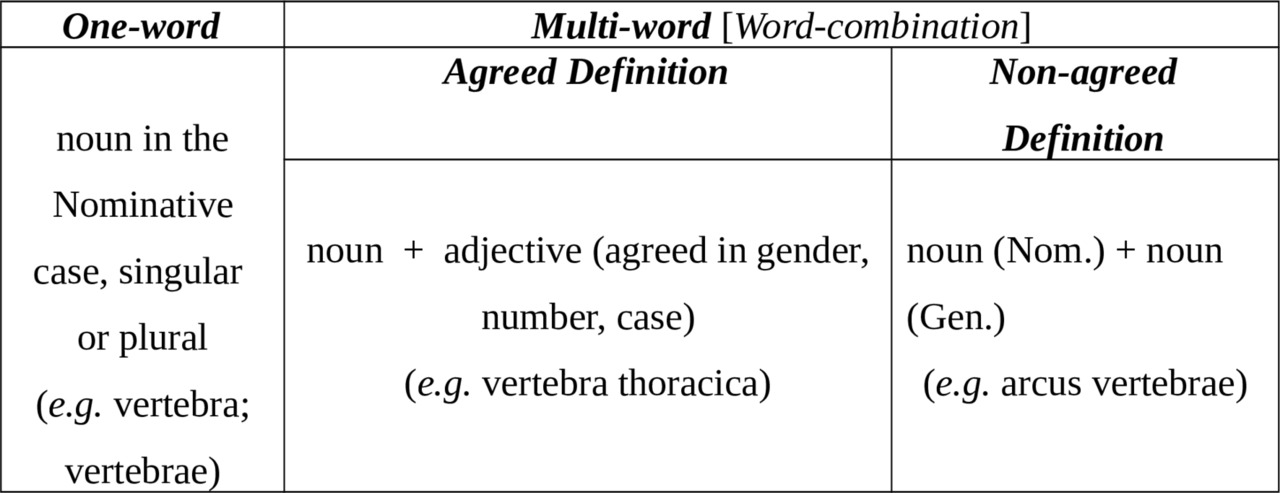
NB! A word-combination can consist of more than two words.
NB! A Latin non-agreed definition can be translated into English by two ways: with the preposition of (arch of the vertebra) or with a chain of nouns (vertebra arch).
NOUN
Endings of nouns of Declensions I -V in Nom. and Gen. sing. forms

NB! In all declensions, except for declension III, the stem coincides in Nom. and Gen. forms, i.e. remains unchangeable.
NB! The dictionary form of a noun consists of 4 elements: word form in Nom. sing., ending of Gen.sing., designation of the genus, translation: e.g. vertebra, ae f vertebra.
NB! The declension sign is the Genitive singular ending (Gen. sing.), indicated in second place in the dictionary form, after the Nominative singular full form.
Lexical Minimum of Nouns of Declensions I, II, IV and V
Declension I
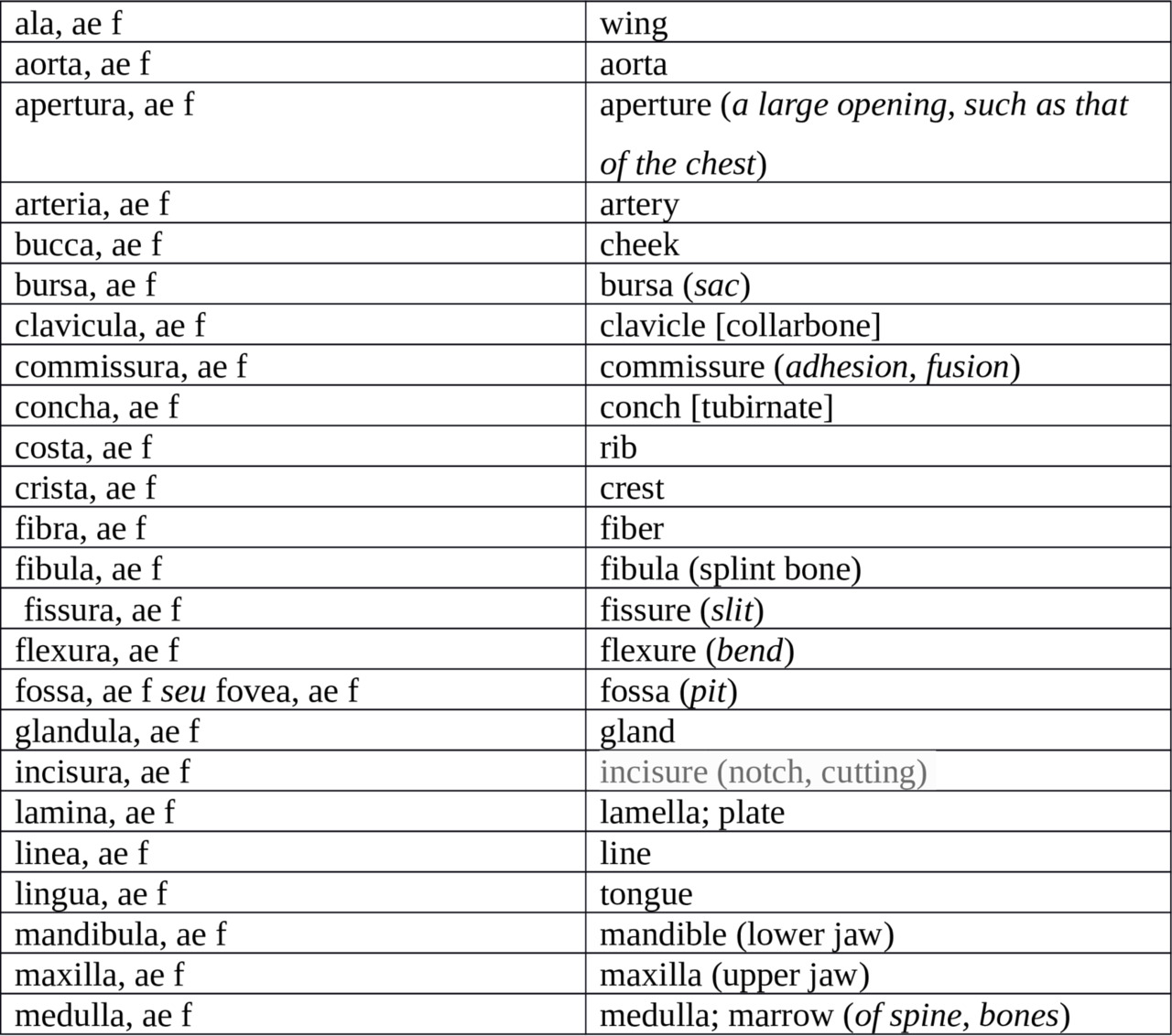
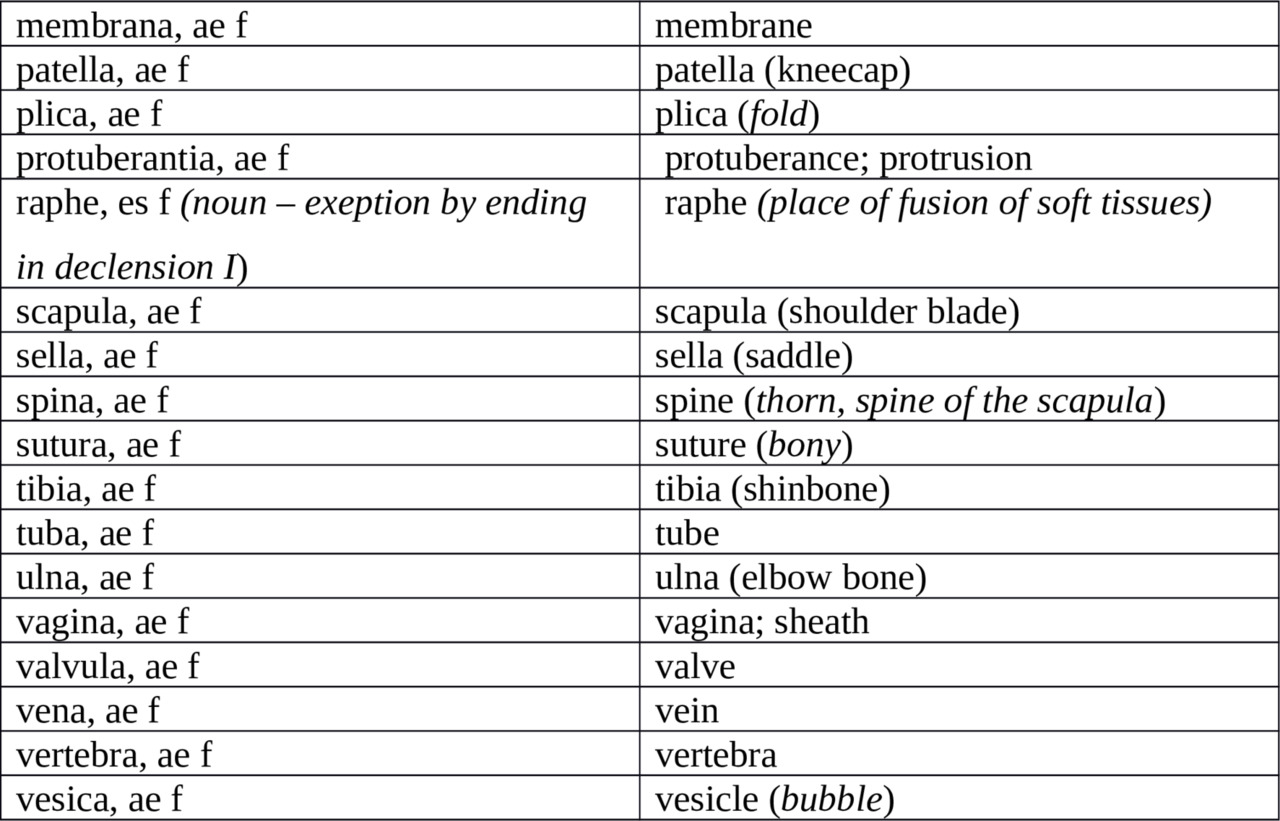
Declension II
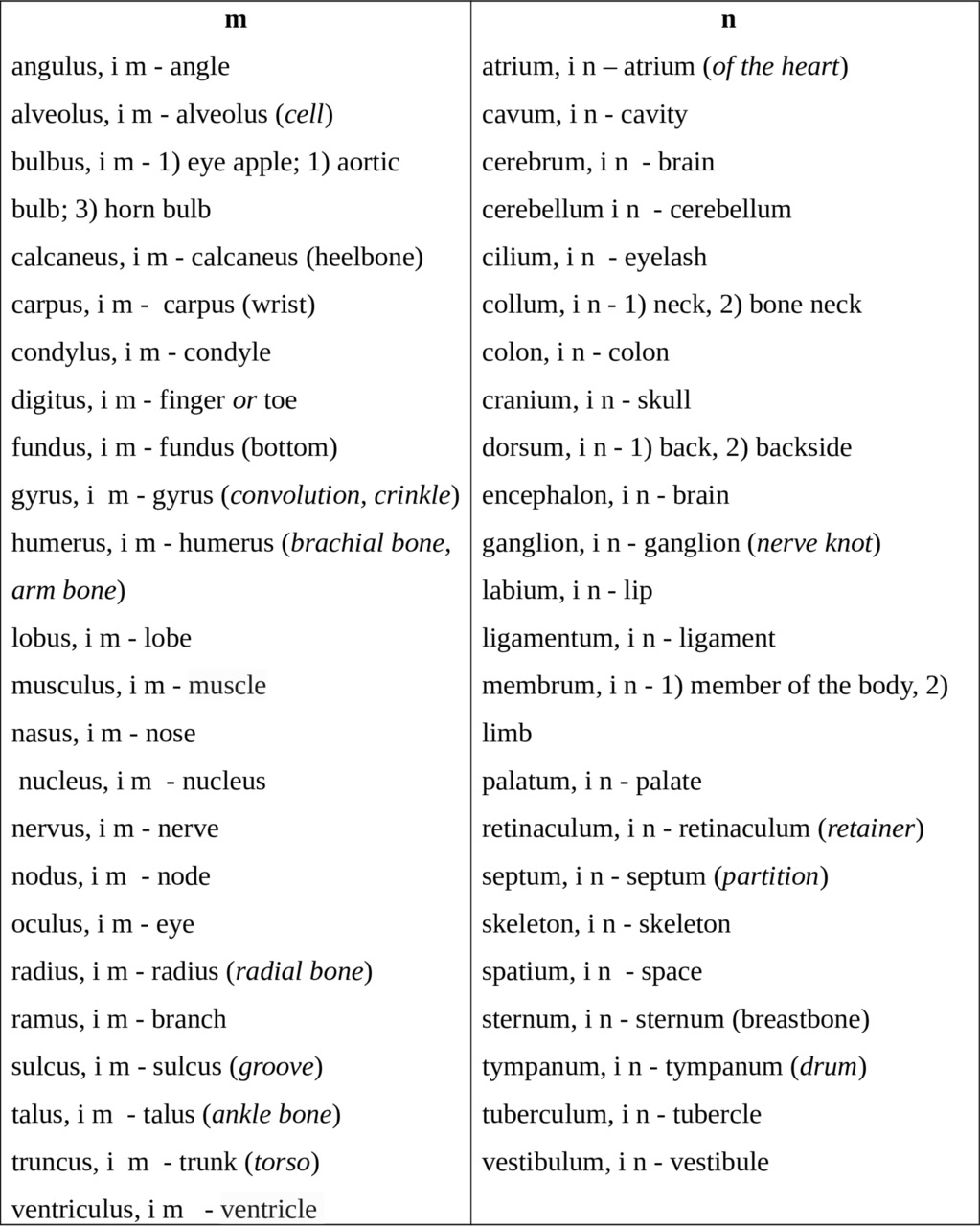
Declension IV
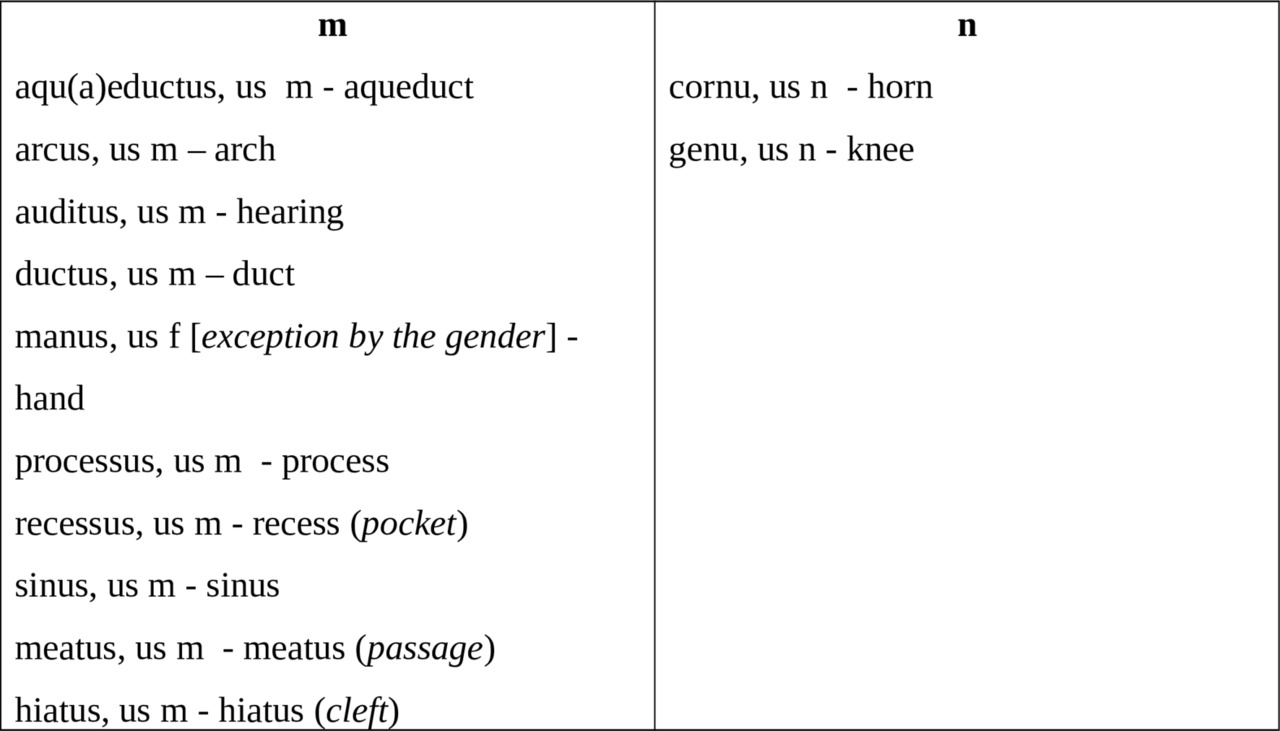
Declension V
facies, ei f — 1) face, 2) surface
Declension III
Masculine Gender

NB! As the stem of the word belonging to declension III in most cases does not coincide in Nom. sing. and Gen. sing. forms, it can be found by the Gen. sing. form only, by the way of dropping the ending –is. The Gen. sing. stem is practical and productive, i.e. it joins the endings of all the other cases and plural number, as well as suffixes when producing other speech parts. For example: tendo, inis m — tendon, the practical stem of the Latin word is tendin-.
NB! It is important to remember that the masculine gender of declension III includes names of muscles by function. Muscle names by function consist of two words: the word musculus and the masculine noun of declension III, which designates the function: musculus constrictor, musculus abductor, etc. So, both words in the term are nouns, have the same gender, number and case, but belong to the different declensions (the noun musculus is of declension II). If such a term is followed by another noun, then the latter is used in the Genitive case: constrictor muscle of pharynx — musculus constrictor pharyngis.
NB! In writing, the word musculus is usually shortened to m.: m. constrictor.
NB! If a noun of declension III consists if one syllable only, the full form of Genetive singular is given in its dictionary form: pes, pedis m — foot; the stem is ped-.
Lexical Minimum of Masculine Nouns of Declension III
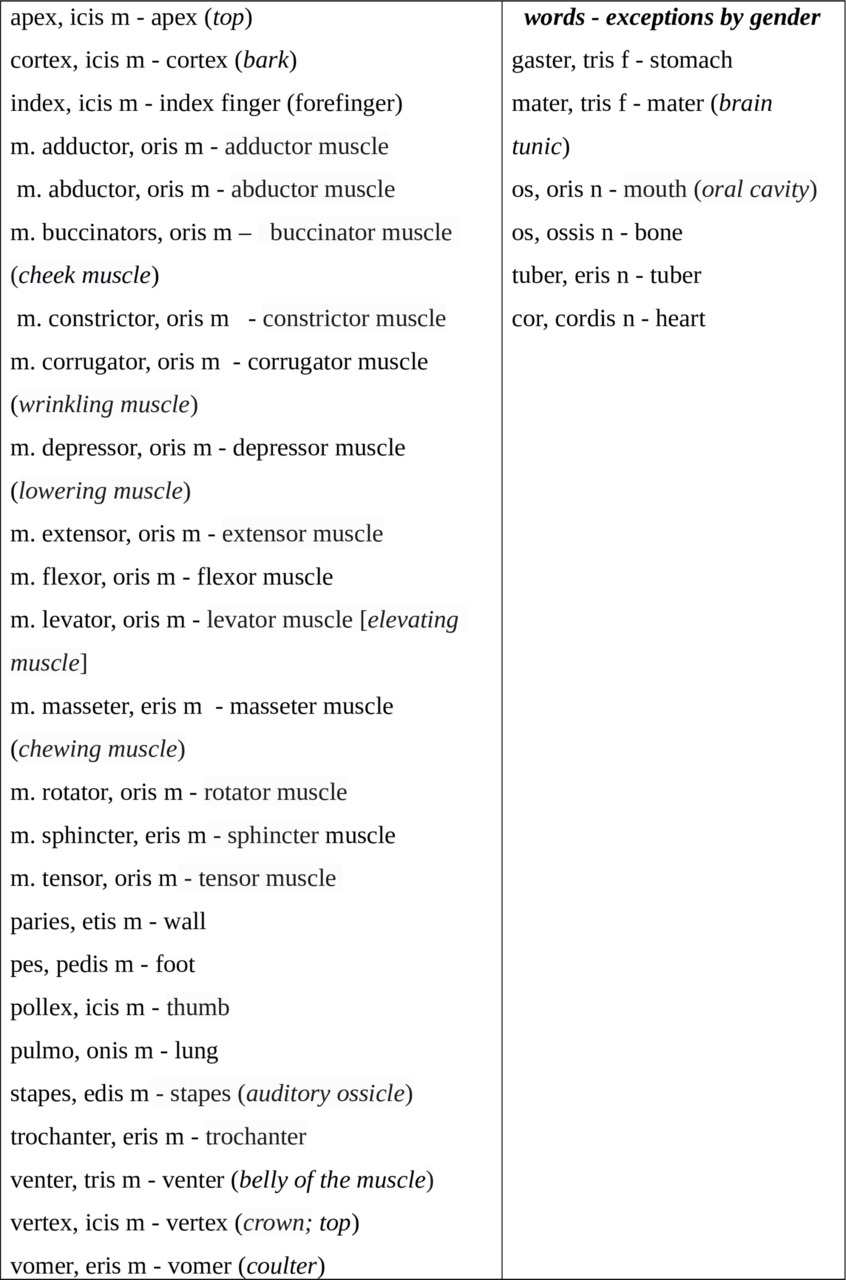
Feminine Gender

Lexical Minimum of Feminine Nouns of Declension III
Бесплатный фрагмент закончился.
Купите книгу, чтобы продолжить чтение.